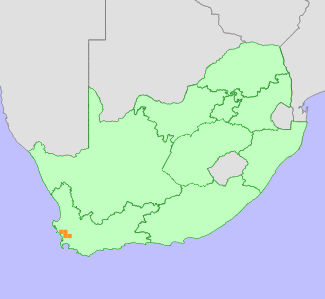|
Scientific Name | Serruria linearis Salisb. ex Knight |
Higher Classification | Dicotyledons |
Family | PROTEACEAE |
Synonyms | Serruria simplicifolia R.Br. |
Common Names | Needle-leaf Spiderhead (e) |
National Status |
Status and Criteria | Endangered A2ce |
Assessment Date | 2020/08/08 |
Assessor(s) | A.G. Rebelo, D. Raimondo, L. von Staden & R. Koopman |
Justification | Serruria linearis is a range-restricted species, with an extent of occurrence (EOO) of 265 km², and an area of occupancy (AOO) of 128 km². A population reduction of 50-60% over three generations is inferred from habitat loss over the past 150-300 years. There is a continuing decline due to ongoing agricultural use, competition from alien invasive plants and inappropriate fire management. It therefore qualifies as Endangered under criterion A. |
Distribution |
Endemism | South African endemic |
Provincial distribution | Western Cape |
Range | This species has a very limited distribution in the Western Cape Province, South Africa, where it occurs between Mamre and Malmesbury. |
Habitat and Ecology |
Major system | Terrestrial |
Major habitats | Swartland Granite Renosterveld, Atlantis Sand Fynbos |
Description | It grows on sandy flats, 50-300 m. It is a long-lived species (generation length 50-100 years), and survives fires by resprouting from an underground rootstock. Seeds are released after ripening, and dispersed by ants to their underground nests, where they are protected from predation and fire. It is pollinated by insects. |
Threats |
| About 61% of this species' habitat is irreversibly modified. Loss of habitat is mainly due to urban expansion (small holdings) and agriculture (crop and pasture cultivation). Ongoing crop cultivation remains a threat. The remaining fragments are threatened by lack of fire, infestations by alien invasive acacias, and grazing by livestock. |
Population |
This species is known from a 20 km long range. A population reduction of 50-60% is inferred from habitat loss over the past three generations (150-300 years). Most of its remaining habitat is in fragments, the largest subpopulations are centred on Riverlands and Pella nature reserves where there is ongoing pressure from invasive alien plant invasion. Population decline continues due to ongoing severe habitat degradation as a result of alien plant infestations and livestock overgrazing.
|
Population trend | Decreasing |
Conservation |
| It is present in the Riverlands and Pella nature reserves where there is a large subpopulation. Less than 100 plants occur in the Kalabaskraal Nature Reserve. |
Assessment History |
Taxon assessed |
Status and Criteria |
Citation/Red List version | | Serruria linearis Salisb. ex Knight | EN A3c+4c | Raimondo et al. (2009) | | Serruria linearis Salisb. ex Knight | Endangered | Hilton-Taylor (1996) | | Serruria linearis Salisb. ex Knight | Rare | Hall et al. (1980) | |
Bibliography |
Goldblatt, P. and Manning, J.C. 2000. Cape Plants: A conspectus of the Cape Flora of South Africa. Strelitzia 9. National Botanical Institute, Cape Town.
Hall, A.V., De Winter, M., De Winter, B. and Van Oosterhout, S.A.M. 1980. Threatened plants of southern Africa. South African National Scienctific Programmes Report 45. CSIR, Pretoria.
Hilton-Taylor, C. 1996. Red data list of southern African plants. Strelitzia 4. South African National Botanical Institute, Pretoria.
Manning, J.C. and Goldblatt, P. 2012. Plants of the Greater Cape Floristic Region 1: The Core Cape Flora. Strelitzia 29. South African National Biodiversity Institute, Pretoria.
Raimondo, D., von Staden, L., Foden, W., Victor, J.E., Helme, N.A., Turner, R.C., Kamundi, D.A. and Manyama, P.A. 2009. Red List of South African Plants. Strelitzia 25. South African National Biodiversity Institute, Pretoria.
Rebelo, T. 2001. Sasol Proteas: A field guide to the proteas of southern Africa. (2nd ed.). Fernwood Press, Vlaeberg, Cape Town.
|
Citation |
| Rebelo, A.G., Raimondo, D., von Staden, L. & Koopman, R. 2020. Serruria linearis Salisb. ex Knight. National Assessment: Red List of South African Plants version . Accessed on 2025/05/31 |
 Comment on this assessment
Comment on this assessment

